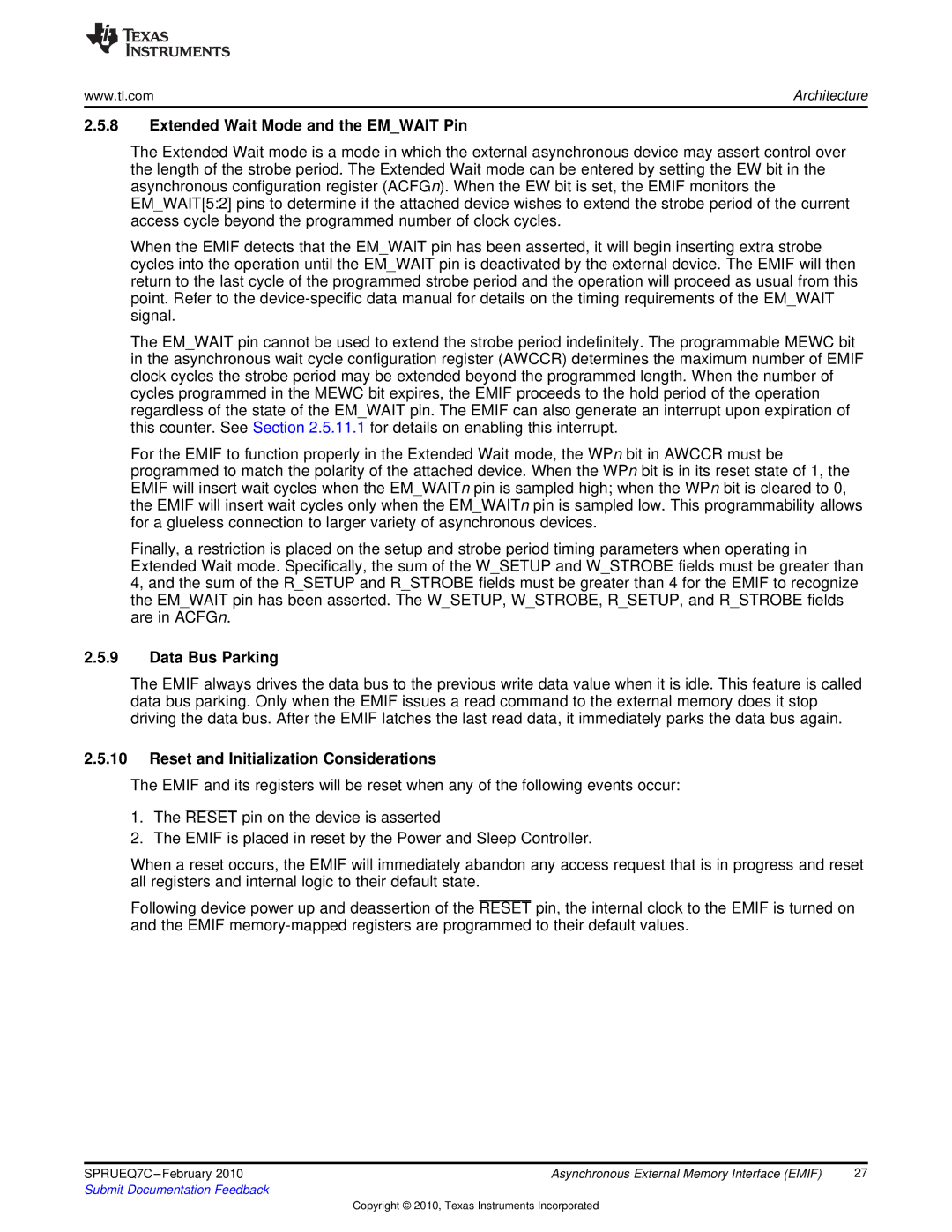
www.ti.com | Architecture |
2.5.8Extended Wait Mode and the EM_WAIT Pin
The Extended Wait mode is a mode in which the external asynchronous device may assert control over the length of the strobe period. The Extended Wait mode can be entered by setting the EW bit in the asynchronous configuration register (ACFGn). When the EW bit is set, the EMIF monitors the EM_WAIT[5:2] pins to determine if the attached device wishes to extend the strobe period of the current access cycle beyond the programmed number of clock cycles.
When the EMIF detects that the EM_WAIT pin has been asserted, it will begin inserting extra strobe cycles into the operation until the EM_WAIT pin is deactivated by the external device. The EMIF will then return to the last cycle of the programmed strobe period and the operation will proceed as usual from this point. Refer to the
The EM_WAIT pin cannot be used to extend the strobe period indefinitely. The programmable MEWC bit in the asynchronous wait cycle configuration register (AWCCR) determines the maximum number of EMIF clock cycles the strobe period may be extended beyond the programmed length. When the number of cycles programmed in the MEWC bit expires, the EMIF proceeds to the hold period of the operation regardless of the state of the EM_WAIT pin. The EMIF can also generate an interrupt upon expiration of this counter. See Section 2.5.11.1 for details on enabling this interrupt.
For the EMIF to function properly in the Extended Wait mode, the WPn bit in AWCCR must be programmed to match the polarity of the attached device. When the WPn bit is in its reset state of 1, the EMIF will insert wait cycles when the EM_WAITn pin is sampled high; when the WPn bit is cleared to 0, the EMIF will insert wait cycles only when the EM_WAITn pin is sampled low. This programmability allows for a glueless connection to larger variety of asynchronous devices.
Finally, a restriction is placed on the setup and strobe period timing parameters when operating in Extended Wait mode. Specifically, the sum of the W_SETUP and W_STROBE fields must be greater than 4, and the sum of the R_SETUP and R_STROBE fields must be greater than 4 for the EMIF to recognize the EM_WAIT pin has been asserted. The W_SETUP, W_STROBE, R_SETUP, and R_STROBE fields are in ACFGn.
2.5.9Data Bus Parking
The EMIF always drives the data bus to the previous write data value when it is idle. This feature is called data bus parking. Only when the EMIF issues a read command to the external memory does it stop driving the data bus. After the EMIF latches the last read data, it immediately parks the data bus again.
2.5.10Reset and Initialization Considerations
The EMIF and its registers will be reset when any of the following events occur:
1.The RESET pin on the device is asserted
2.The EMIF is placed in reset by the Power and Sleep Controller.
When a reset occurs, the EMIF will immediately abandon any access request that is in progress and reset all registers and internal logic to their default state.
Following device power up and deassertion of the RESET pin, the internal clock to the EMIF is turned on and the EMIF
SPRUEQ7C | Asynchronous External Memory Interface (EMIF) | 27 |
Submit Documentation Feedback |
|
|
Copyright © 2010, Texas Instruments Incorporated
